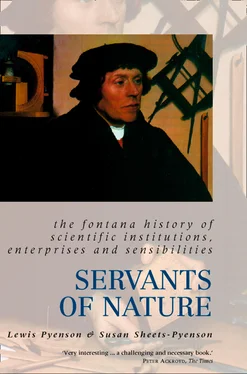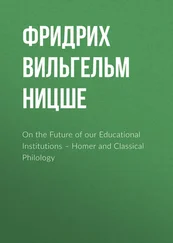Intelligencers like Justel and Oldenburg depended upon travellers and diplomats to transmit their parcels and letters. A network of courtiers, statesmen, and civil servants scattered across the Continent, the Near East, and the New World provided Oldenburg with the machinery for collecting information and gaining new foreign agents. Oldenburg’s contacts, who introduced him to local virtuosi, sent summaries of new books, reports of experiments, and simple accounts of everyday scientific activity. Formal relations between the Royal Society and foreign academies were merely polite and sterile; virtually all news of Continental science went to Oldenburg from Justel or from Englishmen abroad.
The importance of these connections suggests that the rise of scientific societies has depended on the emergence of the apparatus of the modern state. Departing from traditional Marxist arguments by which science is driven by economic need, the demands of capitalism failed to dictate a set of problems to seventeenth-century researchers. Rather, the expansion of trade and commerce associated with the rise of capitalism provided a means of collecting and amassing valuable information. Groups in one geographical location could be brought into communication with like-minded individuals elsewhere. Essentially, seventeenth-century mercantile developments nurtured and sustained the evolution of learned societies.
Eighteenth-century expansion
A century after the creation of the Royal Society and the Académie des Sciences there were around two hundred societies devoted to science or technology. In France alone, twenty-five provincial academies appeared by the eve of the French Revolution. Generally speaking, these societies stimulated research and provided for the diffusion of that research through their publications. The appellation of ‘literary society’ – characteristic of eighteenth-century societies – refers less to their cultivation of belles lettres than to their concern with scientific literature.
Over the course of the eighteenth century, learned societies emerged, as James McClellan puts it, as ‘the characteristic form for the organization of culture’ throughout the Western world and its spheres of influence. A host of subsets of these societies might be discussed, but for our purpose those exclusively or even partially devoted to science (along with literary studies or technology) are the most interesting. Their exponentially increasing number outdistanced other institutional forms of scientific activity, whether botanical gardens, observatories, or universities. No leading scientist was without an affiliation to one of them. Not only did they sponsor publications, but they endowed prizes and funded expeditions. McClellan understands the flourishing of scientific academies during the last half of the eighteenth century as ‘an unprecedented development in the organizational and institutional history of science’. As he demonstrates, by the end of the eighteenth century, scientific societies extended ‘from Philadelphia and Kentucky in the west to Saint Petersburg (or arguably Batavia, the East Indies) in the east, and from Trondheim (Norway) in the north to Sicily and Haiti in the south’.
The establishment of learned societies during the eighteenth century became an international movement, reaching its peak in the 1780s. These institutions were concentrated in European urban centres, particularly in France. Few nations failed to support scientific societies; only the European capital cities of Spain and Austria were without them. They were – alongside churches, courts of law, and universities – manifestations of high culture, with all its implications of exclusiveness. Only during the next century would this fundamental characteristic of scientific societies be altered; no longer would they be the exclusive prerogative of a learned and powerful elite.
Eighteenth-century developments may be categorized according to the two dominant models for scientific organization established during the seventeenth century. One was that of the Paris Académie des Sciences, the generic ‘academy’, frequently found on the Continent. The other, the ‘society’ model exemplified by the Royal Society, emerged in the less stratified societies of Britain, the United States, and Holland. Both types are united by their possession of chartered corporate status and written rules. They convened regular meetings, appointed officers, and elected a restricted number of fellows. In addition to official quarters, they often claimed libraries, collections, botanical gardens, and observatories.
Important distinctions, however, may also be drawn between the academy and society models. Academies, more so than societies, tended to be state-supported institutions; the state accordingly extracted its due by controlling their duties and responsibilities. Societies enjoyed much more autonomy and independence, but because they lacked a clearly defined mission, they tended to be less productive. The internal structure of the two forms of scientific institution differed significantly, which may be illuminated by comparing the Académie des Sciences with the Royal Society.
The Académie des Sciences possessed a restricted, yet heterogeneous membership, stratified in a strict hierarchy. Its officers were drawn from its two constituent classes, the regular and the honorary members. At the top of the scientific core of regular members ( pensionnaires , who were paid pensions for their services) were eighteen individuals, three of whom represented each of the Académie’s six sections: mathematics, astronomy, mechanics, anatomy, chemistry, and botany, in addition to the permanent secretary and treasurer. Below them in the hierarchy were twelve associate and twelve adjunct members. Nonresident members who did not have to attend meetings but who were excluded from decision-making came next: twelve members from the provinces, eight distinguished foreign scientists, and seventy corresponding members. On average, the Académie could claim just over one hundred and fifty members at any point during the eighteenth century, with fewer than fifty among the resident scientific core. In total, only 716 men belonged to the Académie over the course of the century.
The Royal Society – ‘larger, less professional and exclusive, and more homogeneous’, in the words of James McClellan – was no match for the success of the Académie des Sciences, where scientific accomplishment, finally, was the currency of admission. The Royal Society averaged 325 fellows, seven times the size of the core group in Paris, with nonscientists outnumbering scientists two to one. Election was decided by the membership itself. Without any internal differentiation of its membership into categories or classes, the society became too unwieldy to conduct administrative matters, let alone prosecute any kind of joint scientific endeavours, at its weekly meetings. During the eighteenth century, a twenty-one member elected council, led by an increasingly powerful president, assumed all administrative responsibilities and became the ‘guiding force’ of the Society.
Both the Paris Académie and the Royal Society spawned imitators elsewhere. Academies in Montpellier, Turin, and Mannheim, for example, imitated Paris’s example. Boston’s American Academy of Arts and Sciences and Philadelphia’s American Philosophical Society copied the Royal Society. A new hybrid form introduced during and characteristic of the eighteenth century was the ‘universal’ society devoted to both science and the arts. The Royal Society of Edinburgh contained literary and scientific sections; the Royal Irish Academy was divided into science, belles lettres , and antiquities. The typical French provincial society dedicated itself to science, belles lettres , and the mechanical arts. German academies often focused on wissenshaftlichen disciplines. Those in Göttingen and Prague had sections for physical, mathematical, and historical sciences. As McClellan summarizes this diversity, when resources were scarce, the ‘multi-area’ institution was adopted; the ‘single field type’ emerged where resources were plentiful.
Читать дальше












